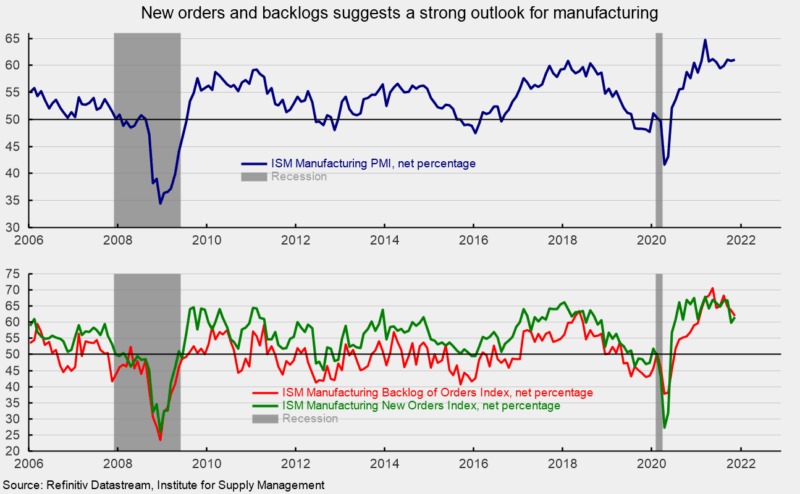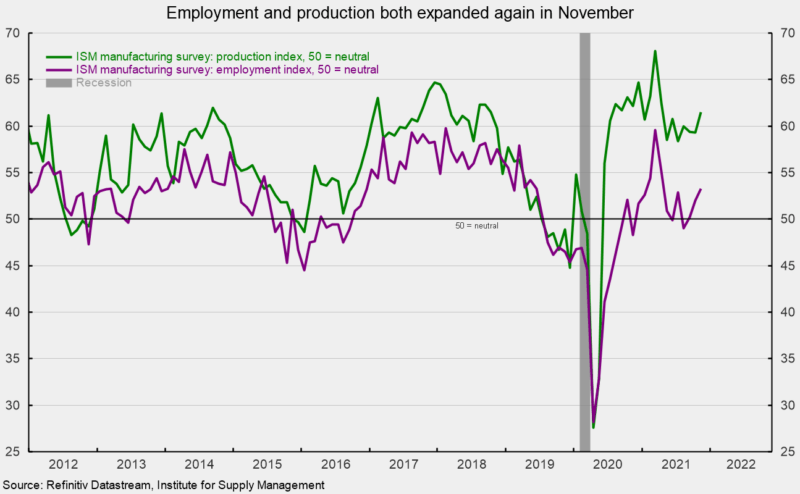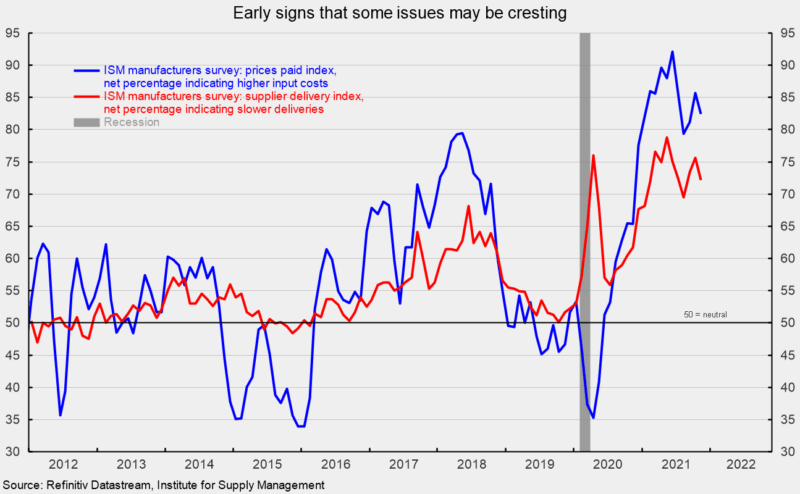Strong Demand Continues for the Manufacturing Sector
The Institute for Supply Management’s Manufacturing Purchasing Managers’ Index rose to 61.1 in November, up 0.3 points from 60.8 percent in October. November is the 18th consecutive reading above the neutral 50 threshold and the ninth month above 60 in the last 12 months (see top of first chart). The survey results suggest that the manufacturing sector continues to expand at a robust pace.
Demand measures remained robust with the New Orders Index up 1.7 points to 61.5 percent in November. The New Orders Index has been above 50 for 18 consecutive months and above 60 for 16 of the last 17 months (see bottom of first chart).
The new export orders index, a separate measure from new orders, fell slightly to 54.0 versus 54.6 in October. The new export orders index has been above 50 for 17 consecutive months.
The Backlog-of-Orders Index decreased again in November, coming in at 61.9 versus 63.6 in October, 64.8 in September, and 68.2 in August (see bottom of first chart). This measure has pulled back from the record-high 70.6 result in May but has been above 50 for 17 consecutive months and above 60 for ten consecutive months. The index suggests manufacturers’ backlogs continue to rise at a rapid, though somewhat slower, pace.
The Production Index registered a 61.5 percent result in November, an increase of 2.2 points from October. The index has been above 50 for 18 months but it is the first reading above 60 since June and the highest since a 62.5 result in April (see second chart).
The Employment Index also rose in November, posting its third consecutive increase and third consecutive reading above the neutral 50 level, rising to 53.3 percent (see second chart). That is the strongest result since April. While labor issues are unlikely to disappear in the short term, the marginally better result may be an early indication that some of the labor issues plaguing production could start to ease a bit in coming months.
The Bureau of Labor Statistics’ Employment Situation report for November is due out on Friday, December 3rd. Consensus expectations are for a gain of 550,000 nonfarm payroll jobs including the addition of 45,000 jobs in manufacturing. Manufacturers have added 44,000 workers per month over the last six months putting payrolls at the highest level over the recovery, but they are still down about 270,000 compared to pre-pandemic levels.
Customer inventories in November are still considered too low, with the index coming in at 25.1, the second-lowest on record, down from 31.7 in October (index results below 50 indicate customers’ inventories are too low). The index has been below 50 for 62 consecutive months. Insufficient inventory may be a positive sign for future production.
The index for prices for input materials eased back in November, coming in at 82.4 percent versus 85.7 percent in October (see third chart). The index is down from a recent peak of 92.1 in June, though it is still very high. Rising input costs have been driven by shortages of materials and labor as well as production issues and logistical and transportation problems. Those issues are reflected in the supplier deliveries index which registered a 72.2 result in November. This suggests deliveries slowed again in November but at a slightly slower pace. While both these indexes are at high levels, the modest easing over the last few months could be an early sign that some of the issues restraining supply may start to ease in coming months. That possibility is also reflected in some of the comments made by respondents to the survey.
“Petrochemical supply chain is slowly showing signs of improvement after multiple weather disruptions in 2021.” [Chemical Products]
“While steel plate and hot-rolled coil pricing seems to be approaching a plateau, the biggest challenge we have at the moment is finding qualified workers.” [Fabricated Metal Products]
“We are still seeing shortages with various metals. Plastic resins seem to be slowly improving. Electronic component lead times are still moving out.” [Electrical Equipment, Appliances & Components]
“We are starting to catch a break in plastic resins, with (November) prices lower in both ethylene and propylene-based resins. Starting to notice improvement in availability/lead time as well.” [Plastics & Rubber Products]
Overall, demand for the manufacturing sector remains robust but labor difficulties, materials shortages, and logistical problems continue to hamper the ability to meet that demand. Many of these problems will ease over time, and there may be early hints of some progress. However, new waves of Covid threaten to extend the period of normalization and prolong the upward pressure on prices.








